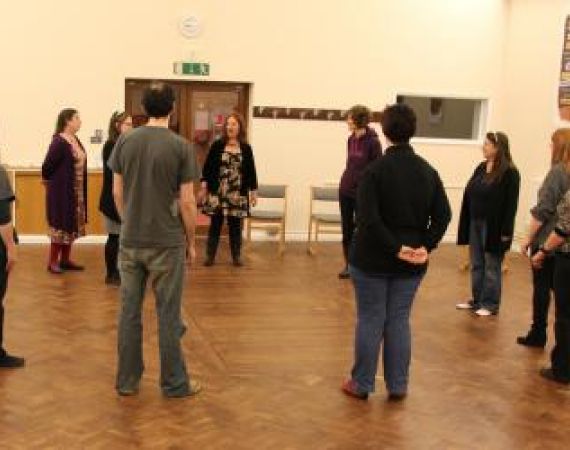Posted on Wed 24 Oct 2012
Second Choir workshop in Bedford – 16th October
A few new faces ! – (and a few absentees – seems to be a cold going around)… and more male voices too. We started off again with vocal warm-ups and a few exercises from the week before – plus a few new versions of a hocket. We re-visited the ‘Target’ piece from last week – and this…

The Choir...
A few new faces ! – (and a few absentees – seems to be a cold going around)… and more male voices too. We started off again with vocal warm-ups and a few exercises from the week before – plus a few new versions of a hocket. We re-visited the ‘Target’ piece from last week – and this time we thought more about ‘detail’ – how we can vary the dynamics, and also, a new ‘rule’ – to be silent and listen for at least a third of the time.
Again – this worked well, and I think it will translate well when used with live sound processing. I then introduced a new structure to work with – with us all lined up in 2 rows, facing each other (yes – comments about line dancing were made!). This idea this time was to walk towards each other singing a held note (all the same note to start with) – and then increase the volume of the note as we passed each other. By making sure each pair starting at different times and walked at different speeds – it was a really effective spatial sound piece that overlapped in different ways all the time. This is definitely going to work well with the sound processing device. We didn’t spend long on this exercise, as time had flown by again, but there is a lot of scope to develop it with different notes / sounds / and by changing different parameters when we cross each other.
For this session, I brought Matt with me to set up the device – as I wasn’t confident I could do that, and I thought is was a good idea to show the choir how it was progressing and get some feedback from them when it is still in development stages.
For the last part of the session – we showed the choir the device, and outlined what it could do. Some members of the choir had a go with it and most people asked questions about it. … I explained that it would be able to do more, and that there would be pre-sets to select different ‘effects’. Even on the most basic setting, a large variety of soundworlds and textures can be created purely depending on the kind of vocal sound recorded in.
From this short experiment, I realized it was going to work, and the choir seemed interested in using live electronics on their voice – and (from my observations) quite excited by the prospect of exploring this further.